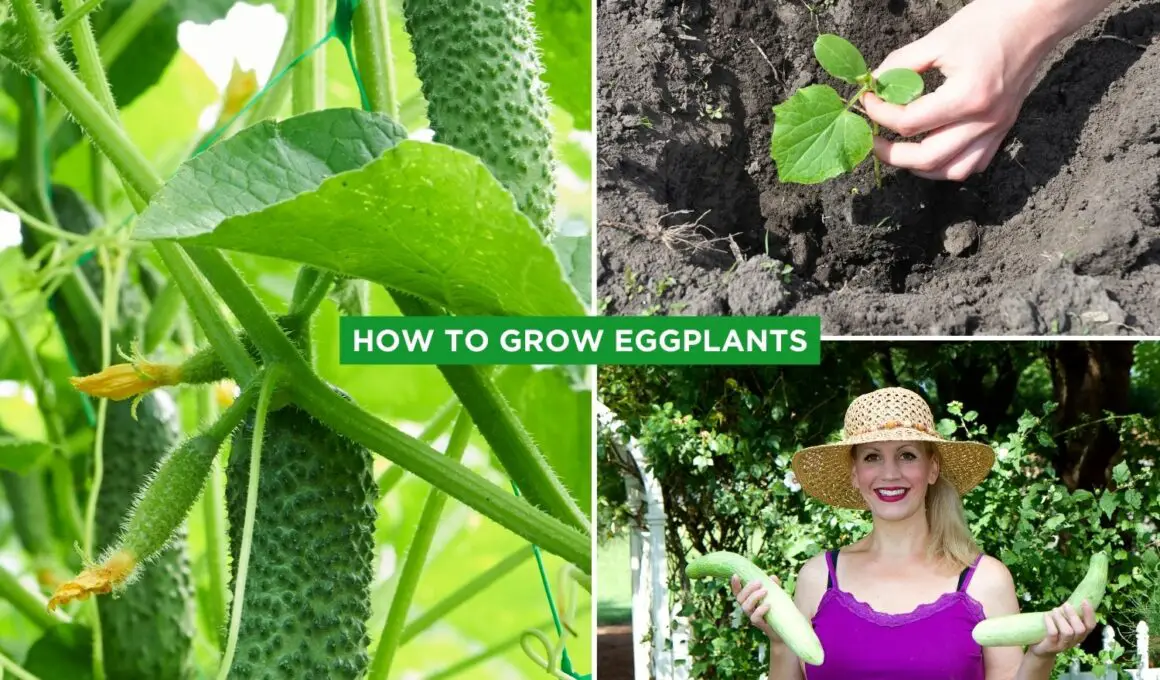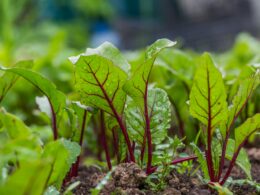In This Article Show
As a seasoned gardener with over 13 years of hands-on experience, I’ve had the joy of cultivating many types of fruits and vegetables in my garden. Yet, there’s one versatile and vibrant veggie that holds a special place in my garden – the eggplant.
In today’s post, we’ll dive into the world of eggplants, those glossy, purple, nutrient-rich wonders that are as beautiful to look at as they are delightful to eat. Whether you’re a seasoned gardener like myself or a novice who’s just getting their gloves dirty, this guide is designed to be your go-to resource for all things eggplant.
We’ll explore everything from the history and types of eggplants to their growing stages, a comprehensive planting and care guide, and tips on harvesting and storage.
Growing eggplants may seem intimidating, but with the right guidance, patience, and a little bit of love, you’ll be able to enjoy your homegrown, nutritious eggplants in no time. With my 13 years of gardening experience, I have learned one thing: gardening should be simple, enjoyable, and rewarding.
Understanding Eggplants
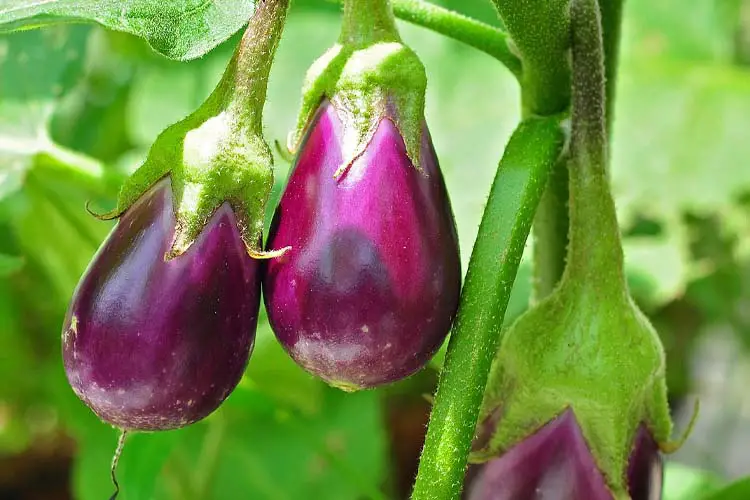
Before we plunge our hands into the soil, it’s important to get to know our plant a bit better. Having a deeper understanding of eggplants will not only make the growing process more interesting but also help you appreciate the fruit (yes, it’s technically a fruit!) even more.
Firstly, the eggplant, also known as aubergine in some parts of the world, is of the nightshade family, which includes tomatoes, potatoes, and bell peppers. Its botanical name is Solanum melongena.
Get Gardening For Beginners
Our new EBOOK shows newcomers and green thumbs alike a step by step guide to growing the garden of their dreams.
The plant is native to India and was cultivated in China as early as the 5th century B.C. Over the years, traders and explorers spread the eggplant across the globe, and it became a staple in many cuisines, from Italian to Thai.
Eggplants come in a range of shapes, sizes, and colors. While the glossy, deep purple variety is most commonly known, eggplants can also be white, green, or striped, and their shapes can range from small and round to large and oblong. Some popular types include ‘Black Beauty’, a large, classic purple variety; ‘White Egg’, a small, white, egg-shaped type; and ‘Rosa Bianca’, an Italian heirloom variety with a sweet, mild flavor and a creamy texture.
Now, let’s talk about nutrition. Eggplants are a fantastic source of vitamins and minerals, including vitamin C, K, B6, and potassium. They are also high in fiber and low in calories, making them a great choice for those aiming for a healthy diet. Plus, they contain certain phytonutrients with antioxidant properties, like nasunin, which helps protect the cells in our body from damage.
So, by choosing to grow eggplants, you’re not only adding a new skill to your gardening repertoire but also opting for a highly nutritious addition to your meals. My 13 years of gardening have taught me the importance of knowing your plants, and with eggplants, there is certainly a lot to know and love!
Preparing for Planting Eggplants
Getting ready to plant your eggplants is a crucial step in the process. Taking the time to prepare can make all the difference in ensuring a successful, fruitful yield. Let’s go through what you need to know to set yourself up for eggplant success.
1. Climate and Soil Conditions
Eggplants are warm-season crops that thrive in temperatures between 70 and 85 degrees Fahrenheit. They need a long growing season, so if you live in a cooler climate, you might want to start your seedlings indoors about 6-9 weeks before the last expected frost date.
As for soil, eggplants prefer well-draining soil with a pH range of 6.3 to 6.8. A little on the sandy side is ideal, but they’ll tolerate other soil types as long as good drainage is ensured. They are heavy feeders, so enrich your soil with compost or well-rotted manure before planting.
Get Gardening For Beginners
Our new EBOOK shows newcomers and green thumbs alike a step by step guide to growing the garden of their dreams.
2. When to Plant Eggplants
In terms of seasonality, you’ll want to plant eggplants in the spring, once the danger of frost has passed and the soil has warmed up. Remember, eggplants are heat lovers, so they won’t do well if planted too early in cold soil.
3. Garden or Pot Preparation
Whether you’re planting in a garden or a pot, you’ll want to prepare your area to give your eggplants the best possible start. If you’re planting in a garden, select a location that receives full sun — eggplants need at least 5-6 hours of sunlight each day.
Prepare the soil by adding organic matter like compost or well-rotted manure, as this will help improve soil fertility and drainage.
If you’re growing eggplants in pots, choose a pot that’s at least 5 gallons in size for standard eggplant varieties, or slightly smaller for dwarf or patio types. Make sure your pot has good drainage holes. You can use a good-quality potting mix, preferably one enriched with compost or a slow-release organic fertilizer.
The Growing Stages of Eggplants
Just like us, plants have life stages. From their beginnings as humble seeds to their mature fruit-bearing phase, each stage is a vital part of the plant’s life cycle. For eggplants, there are five main growing stages. Let’s delve into each one:
1. Seed Germination
The journey of an eggplant begins with a seed. This stage is all about turning that tiny seed into a sprouting plant. After planting the seeds in a warm, moist environment, they will typically germinate within 7-10 days. The seeds begin to swell and soften until the first sign of the plant, known as the radicle (or the embryonic root), emerges.
2. Seedling Stage
After successful germination, the seedling stage begins. This is when the first set of true leaves appears. If you’re starting your eggplants from seeds indoors, this is the stage at which you can start to harden off the seedlings.
Hardening off is the process of gradually exposing indoor-started seedlings to outdoor conditions. It’s a crucial step to prevent transplant shock, which can hinder growth.
3. Vegetative Stage
Following the seedling stage, the eggplant enters the vegetative stage. During this phase, the plant focuses on growing larger and developing more foliage. It’s an important time for photosynthesis, which provides the energy for the plant’s growth.
Adequate sunlight, water, and nutrients are particularly important during this stage. Regular watering and a balanced fertilizer can aid in healthy growth.
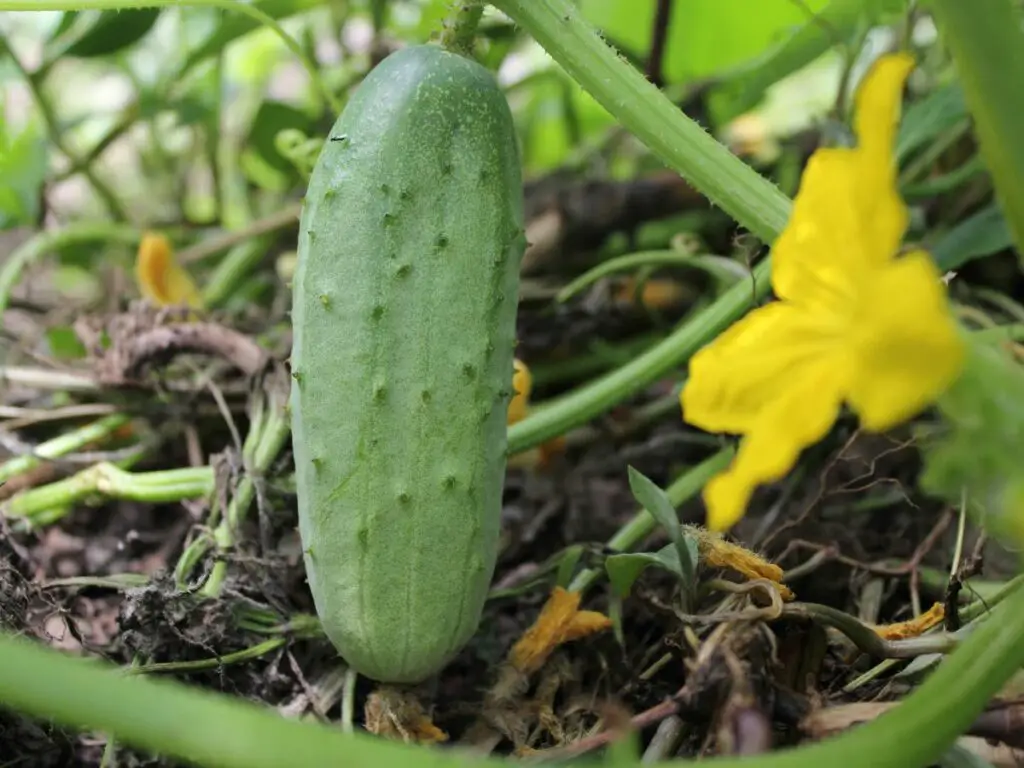
4. Blooming Stage
Once the eggplant has grown sturdy and strong, it will begin to produce flowers — marking the blooming stage. These flowers are usually purple or white, and they signify the upcoming fruit production. It’s vital to continue providing the plant with sufficient water and nutrients during this stage.
5. Fruit Development
The final stage is fruit development. After successful pollination, the eggplant flowers will start to develop into fruit. The fruit’s size, shape, and color depend on the variety of eggplant you’ve chosen to grow. You can expect to see the first signs of fruit about 2-3 weeks after flowering. The fruit typically reaches maturity 70 to 85 days after planting.
Care and attention to your eggplant’s needs are paramount in each of these stages. After the hard work and anticipation, there is nothing quite as rewarding as seeing your eggplant journey from a tiny seed to a fruit-bearing plant.
How to Plant Eggplants
After understanding the growth stages, you’re now ready for the exciting part – planting your eggplants. This is where you will start to see your preparations come to life. Here’s a step-by-step guide to help you plant eggplants like a pro:
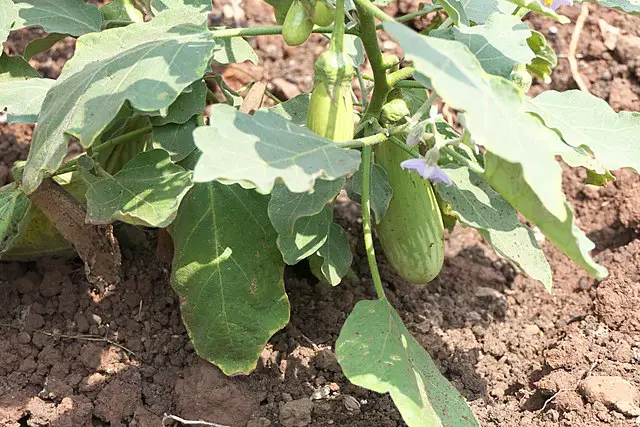
1. Sowing the Seeds (If Starting from Seeds)
Start by sowing the eggplant seeds indoors. Use a seed tray or small pots filled with a seed starting mix. Plant the seeds about 1/4 inch deep. Cover the tray or pots with plastic wrap to maintain a humid environment for the seeds, and place them in a warm area. As mentioned earlier, the seeds should germinate within 7–10 days.
2. Transplanting the Seedlings
Once your seedlings have developed a few true leaves and the outdoor temperature is consistently above 70 degrees Fahrenheit, it’s time to transplant them to your garden or pot. Start by hardening off your seedlings for about a week to acclimate them to the outdoor conditions.
3. Preparing the Planting Area
While hardening off your seedlings, prepare your garden bed or pot. Dig holes that are about twice the width of the seedling’s root ball and spaced about 24-36 inches apart, depending on the variety. Eggplants need plenty of space to grow.
If you’re planting in pots, ensure your pot is large enough and has good drainage. Fill it with a high-quality potting mix enriched with compost or a slow-release organic fertilizer.
4. Planting the Seedlings
Plant the eggplant seedlings at the same depth they were growing in their starter pots. Backfill the holes with soil, gently firming it around the base of the plant. If you’re using a pot, make sure the top of the root ball is level with the soil surface.
5. Aftercare
Water the plants well after planting. Mulching around the base of the plants can help retain soil moisture and suppress weeds.
From here, it’s a matter of providing regular care for your eggplants as they grow and mature. This includes watering, fertilizing, and keeping an eye out for pests or diseases.
Eggplant Care Guide
Once you’ve planted your eggplants, your journey isn’t over yet! Eggplants need regular care and attention to ensure they grow healthy and strong. Here’s your guide to caring for your eggplants:
1. Watering
Eggplants need a steady supply of water, especially during dry periods. It’s best to water deeply and less frequently, as this encourages the roots to grow deeper into the soil.
Aim for about an inch of water per week, but adjust as necessary based on your local weather conditions. Always water at the base of the plant to avoid wetting the leaves, which can promote disease.
2. Fertilizing
Eggplants are heavy feeders, so they benefit from regular fertilization. Start by mixing compost or a slow-release granular fertilizer into the soil at planting time. Then, provide additional feedings with a balanced liquid fertilizer every 2-3 weeks throughout the growing season.
3. Mulching
Mulch around the base of your eggplants to help conserve moisture, suppress weeds, and regulate soil temperature. Organic mulches like straw or shredded leaves work well and will gradually break down, adding nutrients to the soil.
4. Pruning
While eggplants don’t typically require heavy pruning, removing a few of the older leaves can help increase airflow around the plant and reduce the risk of disease. You can also pinch off the tips of the plant when it reaches about 2 feet tall to encourage bushier growth.
5. Pest and Disease Control
Keep an eye out for common pests like aphids, flea beetles, and Colorado potato beetles. Natural predators, insecticidal soaps, and neem oil can help manage these pests.
As for diseases, eggplants can be susceptible to fungal infections, especially if the foliage is frequently wet. Watering at the base of the plant, improving airflow, and using disease-resistant varieties can help keep your plants healthy.
Caring for your eggplants might sound like a lot of work, but when you see those glossy, colorful fruits hanging from the plant, you’ll know it was all worth it. Keep up the good work, and soon you’ll be rewarded with a bountiful harvest!
Harvesting and Storing Eggplants
Harvesting and storing your homegrown eggplants is the final step in your gardening journey. It’s a joyous time when all your patience, care, and hard work pay off. Let’s walk through the process:
1. When to Harvest Eggplants
Eggplants are typically ready to harvest 16 to 24 weeks after planting, depending on the variety. The skin of the fruit should be glossy and the color (whether purple, white, or striped) vibrant.
A good test to see if an eggplant is ripe is to press the skin lightly. If it springs back, the eggplant is ready to pick. If the indentation remains, the fruit is still immature.
2. How to Harvest Eggplants
To harvest your eggplants, use a sharp pair of pruning shears or a knife. Cut the stem about an inch above the top of the fruit to avoid damaging the plant or the eggplant. Handle the harvested fruit carefully as the skin can bruise easily.
3. Storing Eggplants
Freshly harvested eggplants are best used right away for the freshest taste. However, if you can’t use them immediately, store eggplants in a cool place, but not as cold as a refrigerator. They do well in temperatures around 50 degrees Fahrenheit.
If you have no other option, you can store them in the refrigerator crisper drawer for a short period but try to use them within a week. Wrapping the eggplants in a paper towel can help prevent moisture loss and prolong their shelf life.
For longer-term storage, you can freeze eggplants. Slice or cube the eggplant, blanch it in boiling water for 2 minutes, then quickly cool it in an ice bath. Drain the pieces, pat them dry, then pack them into freezer-safe containers or bags. Frozen eggplant is great for stews, curries, or eggplant parmesan.
Congratulations! You’ve taken your eggplants from seed to harvest. You’re now ready to enjoy your homegrown, delicious eggplants in your favorite recipes. The final product is a testament to your hard work and patience.
Wrapping it Up
Growing your own eggplants can be a deeply rewarding experience. It’s a process that demands patience, care and a bit of knowledge, but the result is worth every effort. From preparing the soil to savoring the first bite of your homegrown eggplant, each step is a journey to better understand nature.
With this comprehensive guide, you now have all the tools and knowledge you need to start your eggplant-growing adventure. Remember, every gardening experience is a learning opportunity, so don’t be afraid to experiment and try new things.





